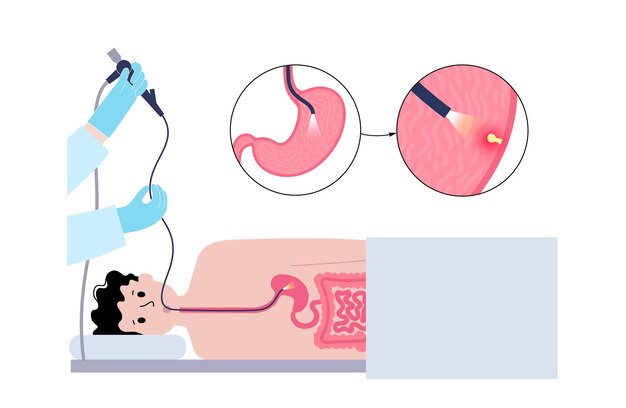Endoscopy and colonoscopy are to view the inside of the human digestive system. These processes help the doctors understand the causes of pain, discomfort, cyst, or bleeding experienced by the patients. Usually, endoscopy is the visual look of the upper alimentary canal, esophagus, throat, and stomach. In comparison, a colonoscopy comes under endoscopy and can help look into the intestines and rectum. Both of these processes are non-surgical and can help examine the digestive tract. And these procedures are performed by specialized instruments. In this blog, we will understand more about Endoscopy vs colonoscopy and identify the How Do Doctors Choose Which procedure to Use? 
 An endoscopy is performed if the doctor needs to look at or examine the upper area of the GI tract, the esophagus, the stomach, and the duodenum. On the other hand, a colonoscopy is performed; the doctor needs to examine the colon through the rectum and ileum. The process of covering the entire intestines or just the rectum will depend of n the following symptoms-
An endoscopy is performed if the doctor needs to look at or examine the upper area of the GI tract, the esophagus, the stomach, and the duodenum. On the other hand, a colonoscopy is performed; the doctor needs to examine the colon through the rectum and ileum. The process of covering the entire intestines or just the rectum will depend of n the following symptoms-
Endoscopy vs Colonoscopy:-

- Endoscopy is a procedure performed with the help of an endoscope and can be done with the help of a long thin, flexible tube with a camera on its end. This camera can help provide high-quality images of the throat, esophagus, and colon.
- The endoscope has a fixed size and position and will not move along the digestive tract. Thus it will not help view the small or large intestine. The endoscope can only move to the stomach and capture more than 50,000 images during its insertion into the throat.
- A colonoscopy is done with a colonoscopy which carries a camera at the end and can capture images of the intestines. This instrument is a flexible material, and it is inserted from the rectum. This helps in giving detailed views of the rectum and colon and can help check for cancer in the rectum and colons.
- Cancerous polyps, if present during the colonoscopy, are removed as they can prevent the deadly disease.
When do you need to get an endoscopy or a colonoscopy?
 An endoscopy is performed if the doctor needs to look at or examine the upper area of the GI tract, the esophagus, the stomach, and the duodenum. On the other hand, a colonoscopy is performed; the doctor needs to examine the colon through the rectum and ileum. The process of covering the entire intestines or just the rectum will depend of n the following symptoms-
An endoscopy is performed if the doctor needs to look at or examine the upper area of the GI tract, the esophagus, the stomach, and the duodenum. On the other hand, a colonoscopy is performed; the doctor needs to examine the colon through the rectum and ileum. The process of covering the entire intestines or just the rectum will depend of n the following symptoms- - Stomach pain and gas
- Digestive tract bleeding
- Constipation or diarrhea conditions
- Gastritis
- Colorectal cancer
- Cramps
- Blood stools
- Rectal bleeding
- Changes in bowel movement
- Let your doctor know if you are pregnant.
- Have a lung or heart condition.
- Take any blood thinners.
How are these procedures performed: Endoscopy vs colonoscopy?
The main difference between endoscopy and colonoscopy is the insertion of the respective instruments into the body.- In the upper endoscopy, the person is sedated, and the endoscope is entered via the mouth while the person is sedated. The endoscope moves through the throat to the esophagus, stomach, and duodenum. It is a non-surgical process and can also be a treatment option for some conditions.
- Colonoscopy, on the other hand, is a similar process performed during sedatives. But the colonoscope is inserted through the rectum. The person will lie down on the table, and the colonoscope will move up to the rectum to identify abnormalities in the intestines and rectum.
- You can experience minor cramping in both of the processes, and they can last for about 30-60 minutes. They will last an hour at maximum.
- The GI tract can help perform a biopsy and examine polyps, small growths, and other abnormalities. In this process, several anomalies will be removed for analysis. These symptoms will be followed by the physician's orders for a biopsy.
- One should be aware of the cost of the procedure and medical procedures before the day of the operation. You should get your healthcare papers and budget the process.
How should one prepare for endoscopy and colonoscopy?
There is not a lot of preparation required for this procedure, but you can keep these points in mind-- Fasting is required 6 to 8 hours before the process. You should not be drinking water as, well.
- Tell your doctor about ongoing medications or medical conditions.
- Before the procedure, you must cleanse the intestines and body with liquids or laxatives.
- The colon should be clean for doctors to analyze it.
- Your doctor will give you clear-cut instructions to get a clean colon.
Precautions and care after endoscopy or colonoscopy?
Once you have got your reports that you can schedule an appointment with your doctor or can drive yourself to the appointment location-- It would help if you did not drive yourself as you will be sedated. That can make you drowsy.
- Minor bleeding can occur along with cramping and gas feeling after the procedure. These symptoms will be temporary, and one can start eating normally afterward.
- Report to your doctor that the bleeding is excessive and prolonged due to rectal bleeding. You should also get in touch with your doctor if you have extreme cramps, fever, or chills. Otherwise, you can get back to work in a few days.
Conclusion-
Both endoscopy and colonoscopy are performed to check the internal organs of the GI tract or the gastrointestinal tract. The only difference is in the technical procedure of insertion. An endoscope is inserted into the throat, while the colonoscope for the colonoscopy is inserted from the rectum. I hope now you know the major difference between Endoscopy vs colonoscopy. An endoscope is not flexible enough to move past some small parts of the small intestine. At the same time, the colonoscope can move flexibly through the entire small intestines. Professionals should perform both of these procedures, and the doctors should interpret the results. Also Read: 5 Common Gastrointestinal Diseases & their SymptomsFrequently Asked Questions
What does an endoscopy show that a colonoscopy does not?
Colonoscopies can inspect large intestinal copies or images like the colon and rectum, whereas an endoscopy can give the esophagus, stomach, and a few parts of small intestines only.
What is done first, colonoscopy or endoscopy?
The endoscopy of the upper alimentary canal is done before a colonoscopy.
Will a colonoscopy detect colon cancer?
Yes, endoscopy can detect colon cancer, but a different process includes a colon capsule.
Can one get a colonoscopy and endoscopy on the same day?
A bidirectional endoscopy is frequently performed to screen for cancer, polyps, or intestinal bleeding.

Reviewed by







